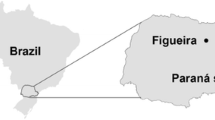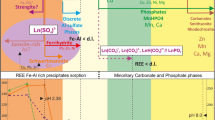Abstract
The Odiel river emerges in Sierra de Aracena (N Huelva, Spain) as a clean, circumneutral river which shows abundant fish and fluvial microfauna. At 20km from the riverhead and along a 7km-long reach, this river receives four small discharges of acid mine water emanating from several abandoned mines of the Iberian Pyrite Belt (namely, Concepción, San Platón, Esperanza and La Poderosa-El Soldado). During two field studies performed in October 2003 and May 2004, it has been observed that these acidic waters (with flow rate of 0.2–8.5L/s and pH 2.3–2.8) transfer to the Odiel river significant amounts of acidity and dissolved metals (specially Fe, Al, Mn, Cu, Zn, Cd, Co and Ni) and sulphate. Despite this mine-related pollution, the pH of the river remains near-neutral (pH = 7–8, flow rate = 220–1,000L/s), as the alkalinity of the river (108–155mg/L CaCO3 eq.) neutralizes the acidity and causes the precipitation of dissolved Fe and Al in the form of ochreous to whitish minerals (ferrihydrite, Al-oxyhydroxides). These poorly crystallized minerals retain, by sorption, large amounts of trace metals (specially Cu and Zn). Subsequently, the Odiel river converges with the acidic Tintillo river (pH = 2.5–2.8, flow rate = 48–240L/s), which drains a vast mining area occupied by large waste-rock piles and tailings impoundments around Corta Atalaya (Riotinto mines). At this confluence, all the alkalinity is totally consumed and the pH drastically decreases to around 3. The mineral paragenesis of the ochreous precipitates is then dominated by schwertmannite, which shows a very limited sorption capacity under such acidic conditions. Consequently, metal concentrations are sharply increased from near-zero to tens of mg/L (e.g., 18mg/L Fe, 76mg/L Al, 14mg/L Mn, 10mg/L Cu, and 20mg/L Zn in May 2004). The buffering capacity of the Fe(III) hydrolysis stabilizes the pH of the Odiel river around 3± 0.5 along the rest of its course to the Huelva estuary, and the water quality of the river is thus irreversibly damaged.
Similar content being viewed by others
References
AYESA: 1996, Estudio de corrección de efluentes cidos en la cuenca del río Odiel. (Technical report with works description). Junta de Andalucía, unpublished report, 30 pp.
Bigham, J. M., Schwertmann, U., Traina, S. J., Winland, R. L. and Wolf, M.: 1996, ‘Schwertmannite and the chemical modeling of iron in acid sulfate waters’, Geochim. Cosmochim. Acta 60, 2111–2121.
Bigham, J. M. and Nordstrom, D. K.: 2000, ‘Iron and aluminum hydroxysulfates from acid Sulfate Waters’, in C. N. Alpers, J. L. Jambor and D. K. Nordstrom (eds.), Sulfate Minerals: Crystallography, Geochemistry, and Environmental Significance, Reviews in Mineralogy & Geochemistry, vol. 40. pp. 351–403.
Braungardt, C. B., Achterberg, E. P., Elbaz-Poulichet, F. and Morley, N. H.: 2003, ‘Metal geochemistry in a mine-polluted estuarine system in Spain’, Appl. Geochem 18, 1757–1771.
Carlson, L. and Schwertmann, U.: 1981, ‘Natural ferrihydrites in surface deposits from Finland and their association with silica’, Geochim. Cosmochim. Acta 45, 421–429.
Cossa, D., Elbaz-Poulichet, F. and Nieto, J. M.: 2001, ‘Mercury in the Tinto-odiel estuarine system (Gulf of Cádiz, Spain): Sources and dispersion’, Aquat. Geochem 7, 1–12.
Davis, J. A. and Kent, D. B.: 1990, ‘Surface complexation modeling in aqueous geochemistry’, in M.F. Hochella and A.F. White (eds.), Mineral-Water Interface Geochemistry: Reviews in Mineralogy, Mineralogical Society of America, Washington, D.C., vol. 23, pp. 177–260.
Elbaz-Poulichet, F., Morley, N. H., Cruzado, A., Velasquez, Z., Achterberg, E.P. and Braungardt, C.B.: 1999, ‘Trace metal and nutrient distribution in an extremely low pH(2.5) river-estuarine system, the Ria of Huelva (South-West Spain)’, Sci. Total Environ 227, 73–83.
Kinniburgh, D. G. and Jackson, M. L.: 1981, ‘Cation adsorption by hydrous metal oxides and clay’, in M. A. Anderson and A. J. Rubin (eds.), Adsorption of Inorganics at Solid-Liquid Interfaces, Ann Arbor Science, Ann Arbor, Mich., pp. 91–160.
Kimball, B. A., McKnight, D. M., Wetherbee, G. A. and Harnish, R. A.: 1992, ‘Mechanisms of iron photoreduction in a metal-rich, acidic stream (St. Kevin Gulch, Colorado, U.S.A.)’, Chemical Geology 96, 227–239.
McKnight, D. M., Kimball, B. A., and Bencala, K. E.: 1998, ‘Iron photoreduction and oxidation in an acidic mountain stream’, Science 240 637–640.
Nordstrom, D. K.: 1982, ‘The effect of sulphate on aluminum concentrations in natural waters: some stability relations in the system Al2O3-SO3-H2O at 298K.’, Geochim. Cosmochim. Acta 46, 681–692.
Nordstrom, D. K. and Alpers, C. N.: 1999, ‘Geochemistry of acid mine waters’, in G. S. Plumlee, and M. J. Logsdon (eds.), The Environmental Geochemistry of Mineral Deposits, Part A. Processes, Techniques, and Health Issues: Society of Economic Geologists, Rev. Econ. Geology vol. 6A, pp. 133–156.
Parkhurst, D. L. and Appelo, C. A. J.: 1999, ‘User's guide to PHREEQC (Version 2) — A computer program for speciation, batch-reaction, one-dimensional transport, and inverse geochemical calculations’, US Geol. Surv. Water-Resour. Investig. Rep. 99–4259, Denver-Colorado.
Pinedo Vara, I.: 1963, Piritas de Huelva (su historia, minería y aprovechamiento). Madrid, Ed. Summa.
Sáinz, A., Grande, J. A. and De la Torre, M. L.: 2003, ‘Analyses of the impact of local corrective measures on the input of contaminants from the Odiel river to the Ría of Huelva (Spain)’, Water, Air and Soil Pollution 144, 375–389.
Sánchez-España, F. J., López Pamo, E., Santofimia, E., Aduvire, O., Reyes, J. and Barettino, D.: 2005 a, ‘Acid Mine Drainage in the Iberian Pyrite Belt (Odiel river watershed, Huelva, SW Spain): Geochemistry, Mineralogy and Environmental Implications’, Applied Geochemistry 20 (7), 1320–1356.
Sánchez, España F. J., López Pamo, E. and Santofimia, E.: (In press), ‘The Oxidation of Ferrous Iron in Acidic Mine effluents from the Iberian Pyrite Belt (Odiel Basin, Huelva, Spain): Field and laboratory rates’, Journal of Geochemical Exploration.
Sánchez-España J., López-Pamo, E., Santofimia, E., Reyes J. and Martín Rubí, J. A.: 2005 b, ‘The natural attenuation of two acidic effluents in Tharsis and La Zarza-Perrunal mines (Iberian Pyrite Belt, Spain)’, Environmental Geology 49, 253–266.
Singer, P. C. and Stumm, W.: 1968, ‘Kinetics of the oxidation of ferrous iron’, Second Symposium Coal Mine Drainage Research, Pittsburgh, PA, pp. 12–34.
Smith, K. S.: 1999, ‘Metal sorption on mineral surfaces: An overview with examples relating to mineral deposits’, in G.S. Plumlee and M.J. Losdon (eds.), The Environmental Geochemistry of Mineral Deposits, Part A. Processes, Techniques, and Health Issues: Society of Economic Geologists, Rev. Econ. Geol., pp. 161–182.
Smith, K. S., Ficklin, W. H., Plumlee, G. S. and Meier, A. L.: 1992, ‘Metal and arsenic partitioning between water and suspended sediment at mine-drainage sites in diverse geologic settings’, in Y. K. Kharaka and A. S. Maest (eds.), Water-Rock Interaction: 7th International Symposium on Water-Rock Interaction, Park City, Utah, July 13-8, 1992, Proceedings, v. 1, Rotterdam, A.A. Balkema, pp. 443–447.
Stumm, W. and Morgan, J. J.: 1996, Aquatic Chemistry, 3rd Ed., John Wiley and Sons, Inc., New York, USA.
Van Geen, A., Adkins, J. F., Boyle, E. A., Nelson, C. H. and Palanques A.: 1997, ‘A 120 yr record of widespread contamination from mining of the Iberian pyrite belt’, Geology 25 (4), 291–294.
Webster, J. G., Swedlund, P. J. and Webster, K. S.: 1998, ‘Trace metal adsorption onto acid mine drainage Fe(III) oxyhydroxysulphate’, Environ. Sci. Technol 32, 1361–1368.
Yu, J., Heo, B., Choi, I. and Chang, H.: 1999, ‘Apparent solubilities of schwertmannite and ferrihydrite in natural stream waters polluted by mine drainage’, Geochim. Cosmochim. Acta 63, 3407–3416.
Author information
Authors and Affiliations
Corresponding author
Rights and permissions
About this article
Cite this article
Sánchez Espańa, J., Pamo, E.L., Pastor, E.S. et al. The Impact of Acid Mine Drainage on the Water Quality of the Odiel River (Huelva, Spain): Evolution of Precipitate Mineralogy and Aqueous Geochemistry Along the Concepción-Tintillo Segment. Water Air Soil Pollut 173, 121–149 (2006). https://doi.org/10.1007/s11270-005-9033-6
Received:
Accepted:
Published:
Issue Date:
DOI: https://doi.org/10.1007/s11270-005-9033-6




